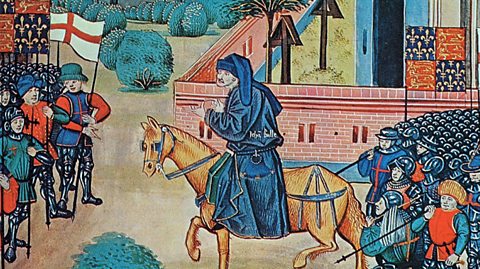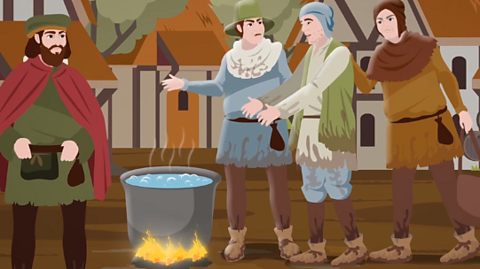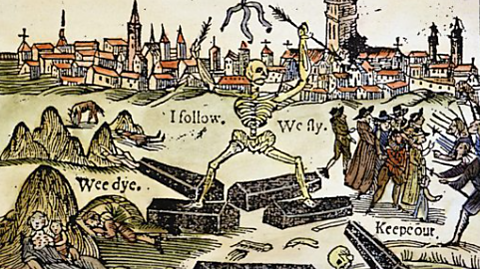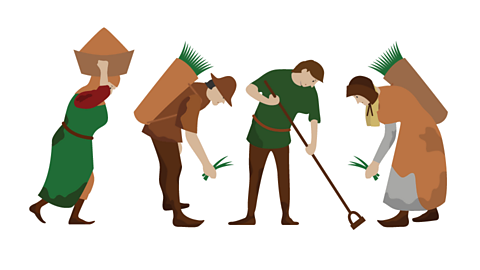Key points
In 1381, peasantDuring the Middle Ages, peasants were people who generally worked in farming, usually earning very little money. They were at the bottom of the medieval social hierarchy. rebelled against King Richard II.
The peasants were angry about a range of issues, such as low pay and the introduction of a poll tax. They demanded changes were made.
The revolt did not achieve all of the peasants’ aims and the leader, Wat Tyler, was killed. In the longer term, there were some changes and improvements to peasants’ rights.
Video
Narrator (peasant man):
As peasants, we led a tough life. We were forced to work long and gruelling hours in the fields for the Lord of the Manor just to pay our rent. We were the lowest part of the feudal system. The plague of the 1340s and 1350s had killed so many people that there were fewer of us to work and more competition for our labour. So those of us who could started to demand more money.
But the wealthy landowners created laws that tried to stop this, to keep their profits high. Our 14-year-old king, Richard the second, needed to fund another war with France and tried to implement a poll tax. We were expected to pay the same amount as the nobles from our tiny wages. In June 1381, Wat Tyler led a group of us from Kent demanding a reduction in taxation and an end to the unfair Feudal System.
The king's armies were stationed elsewhere. So we marched freely into London, joined by many local townsfolk. We attacked jails, set fire to buildings, destroyed the Savoy Palace and fought with Royal officials that got in our way. The Lord Chancellor and Lord Treasurer, two of the king's trusted aides, died in the fighting. King Richard agreed to meet Wat Tyler to make an agreement. But Wat Tyler was wounded and later killed by Richard's men.
The Lord Mayor of London raised an army and, without our leader, we were driven out of the City of London. But other uprisings occurred in East Anglia, Yorkshire and Somerset. Over the following weeks other leaders of the revolt were hunted down and executed by the king and his soldiers. By November, 1500 rebels had been killed. Although the revolt was defeated, many of the things we were fighting for, less harsh laws and more support for the poor, became part of the government system in the long term.
Causes of the Peasants' Revolt
There were several causes of the Peasants' Revolt:
Statute of Labourers: The Black Death of 1348 - 1349 killed up to half of the population in England. A consequence of this was that wages went up, as surviving workers realised they could demand higher pay due to the shortage of labour. Some peasants moved around the country to work for the highest available pay. Landowners were unhappy about having to pay their workers more and put pressure on the government to do something. The Statute of Labourers in 1351 ordered that wages should go back to the level they had been before the Black Death.
John Ball’s preaching: John Ball was a radical preachingWhen a priest delivers a sermon to people, usually in church, about how God guides them to live their lives. who was very critical of the feudalismA system of land ownership to run the country, with the king at the top, followed by the nobility and peasants at the bottom. and the Church. He had been excommunicateTo officially exclude someone from participating in the activities of the Christian Church. in 1366, having delivered sermons in which he suggested that society should not be organised by a class system. Medieval society regarded the monarchy and nobility as more important than the peasants, yet Ball preached that God saw everyone as equal, and that peasants were unfairly treated. His ideas encouraged peasants to demand changes.
Poll tax: England was involved in ongoing wars with France. These were expensive and needed to be paid for. The introduction of a poll taxA tax that is charged to everyone at a fixed rate, regardless of how much money someone earns. in 1377 angered many peasants. They felt this was unfair, as it took a larger proportion of their income.
A new king: In 1377 King Edward III died. He was succeeded by his 10-year-old grandson, King Richard II. Some peasants felt that such a young king could be pressurised into making changes that would improve their lives.
Key events of the Peasants' Revolt
The trigger for the revolt came in May 1381. A tax collector arrived in Fobbing, a village in Essex. The peasants refused to pay the poll tax and their opposition spread to surrounding villages in Essex and Kent.
Peasants gathered together and started to march towards London, led by a man named Wat Tyler. They were joined by supporters from Norfolk and Suffolk.
John Ball spoke to a crowd of peasants at Blackheath, in the south of London. He encouraged them to rebel and demand greater rights.

The crowd burned down buildings and freed prisoners. King Richard and his advisors took shelter in the Tower of London. Richard agreed to meet the peasants at Mile End, and the peasants gave their demands. They wanted to be free to move around the country, and for some of Richard's more unpopular advisors to be handed over for execution. Richard, who was only 14 years old at the time of the uprising, said he would agree to their demands.
Shortly after the meeting at Mile End, peasants stormed the Tower of London and murdered Simon Sudbury, who was the Archbishop of CanterburyThe most senior bishop in England. A bishop is a religious authority figure in the Church. and also the Lord ChancellorA senior member of the government who provided advice and guidance to the monarch.. Robert Hales, who was Lord TreasurerThe head of the treasury, responsible for government spending and taxation., was killed as well.
Richard agreed to meet the peasants again, this time at Smithfield. There is some uncertainty as to what exactly happened when Richard met with Wat Tyler, though historians believe the following to be the most likely sequence of events: Richard told the peasants they should leave London as he had agreed to their demands, but Tyler said he wanted more reforms. Some chroniclers recorded that Tyler looked as though he was going to strike Richard, and the Mayor of London, William Walworth, stepped forward to protect him. Tyler was stabbed, either by the mayor himself, or by Richard’s soldiers. Tyler managed to run away and was taken to a hospital. He was tracked down by the mayor of London, taken back to Smithfield and executed.
Richard rode his horse over to the crowd of peasants. The peasants demanded that he abolish serfdomThe social position of most peasants who were controlled by their landlord. These peasants, known as serfs, were required to work on a particular area of land that was owned by their landlord.. Richard agreed, told the peasants that he was their leader and that they should leave the city. Most of the peasants did leave, believing that the changes Richard had agreed to at Mile End would be put in place. However, Richard did not keep his promises: serfdom was not abolished.
Activity - What's happening in this scene?
The role of women in the Peasants' Revolt
Historians believe that women played a key role in the revolt. Johanna Ferrour was the leader of the group who captured and executed Simon Sudbury. She led rebels from Kent in their march to London.
Records from Suffolk show that 70 women from that county alone were involved in the revolt.
Records from the National Archives show one female leader was accused of encouraging a group to attack the prison at Maidstone in Kent, and another of leading rebels to plunder a number of mansions, leaving servants too scared to return.
It should not be surprising that women joined the revolt. The poll tax of 1380 was charged to all adults, men and women.
The aftermath of the Peasants' Revolt
The revolt had several short term and long term effects:
Richard sent soldiers to round up the rebels. Leaders of the revolt were executed, including the preacher John Ball and the leader of the Essex rebels, Jack Straw.
Although serfdom was not abolished, rules on serfA peasant who had to stay on the land they worked on. They could only leave if they were given the permission of the lord who owned the land. were relaxed over time. They had been forced to stay on the land they worked on, so these changes gave them more freedom to move.
The revolt had largely failed to achieve the changes and improvements that the peasants were looking for, but it did help to show that they had the ability to organise themselves in mass numbers. This served as a warning message to future monarchs that peasants could form a potentially powerful opposition.
A poll tax was not introduced again by any government in England until 1990.
Test your knowledge
Where next?
What was life like in medieval society?
Most medieval people lived in villages, as there were few large towns in the Middle Ages. The majority of people were peasants.

The Great Plague
In 1665, the plague arrived in England once again. In London alone, at least 68,596 people died from the disease, and thousands across the country were killed.

The feudal system
The feudal system helps us to understand how medieval society was organised. There was a big divide between wealthy nobles and peasants.

Play the History Detectives game! gamePlay the History Detectives game!
Analyse and evaluate evidence to uncover some of history’s burning questions in this game.
